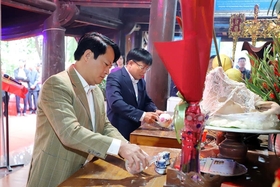{title}
{publish}
{head}
The Cap Sac Ceremony, a significant ritual among the Dao people—particularly the Dao Quan Chet community in Xuan Thuy commune, Yen Lap district—embodies long-standing folk cultural values. For the Dao Quan Chet, a man is only officially recognized by his ancestors and gods as an adult after receiving the Cap Sac. This grants him full rights to participate in worship ceremonies and qualify to undertake responsibilities within the clan and community. In 2019, the Cap Sac Ceremony of the Dao Quan Chet people in Xuan Thuy commune was honored as a National Intangible Cultural Heritage.

During the Cap Sac Ceremony held for Mr. Duong Kim Thuc in Xuan Thuy commune, Yen Lap district, the rituals were performed in a traditional manner.
In late December, Mr. Duong Kim Thuc’s family in zone 10 (Tan Lap area), Xuan Thuy commune, was bustling with activity as preparations for the Cap Sac ceremony took place. At the center of the house, a set of worship paintings was prominently displayed. In addition to shamans, individuals who had previously received the title and those skilled in singing and dancing also participated in the ceremony’s performances.
Mrs. Nguyen Thi Ha, Thuc’s mother, explained, “Thuc is the youngest child in the family. Recently, after attending the Dao Nom class, he has gained a deeper understanding of our customs and traditions. For this important ceremony, we prepared worship paintings, traditional costumes for Thuc and his wife, as well as pigs, chickens, rice, and sticky rice to accommodate the ceremony and celebrate with the villagers.”
In Dao belief, a man attains the heart and virtue to distinguish right from wrong only after undergoing the Cap Sac ceremony. He is then recognized as a descendant of Ban Vuong, qualified to worship ancestors, and entrusted with family responsibilities. The ceremony’s date is carefully chosen to avoid coinciding with a family member’s death anniversary, and the recipient must strictly avoid committing any wrongdoing before the event.
The Cap Sac ceremony holds a central place in Dao culture, strengthening village and community bonds. Through this ritual, cultural values are preserved and passed to younger generations, fostering deeper understanding and appreciation for the Dao people’s traditional identity.
In the Cap Sac ceremony, the rituals are performed in the following order: Ancestor invitation ceremony, master welcoming ceremony, “hanging painting” ceremony, spirit entering ceremony, name-giving ceremony, “Qua Tang” lamp offering ceremony, incense offering ceremony, Jade Emperor invitation ceremony, pest and disease extermination ceremony for crops, military reward ceremony... The duration of the ceremony is usually 3 days 2 nights, or 2 days 2 nights, but today, many families choose to shorten it to 2 days 1 night to suit the actual conditions. The rituals are held at different times, locations, and spaces; some are held during the day, some are held at night, some are held indoors, and some are held in the yard.
Mr. Phung Sinh Thinh—a person who understands the customs and writing in Xuan Thuy commune—said: Unlike other Dao groups, the Dao Quan Chet only performs the Cap Sac ceremony for one person; there is no age limit for the ceremony, but it depends on the conditions of each family to organize it. Therefore, every time the Cap Sac ceremony takes place, members of the community participate in helping from preparing offerings to participating in the practice of the rituals. The activities in the worship ceremony, especially the practice of the rituals, must follow traditional customs and practices under the supervision of gods, shamans, and other clans.
The Cap Sac ceremony has a particularly important position in the culture of the Dao people. Through the Cap Sac ceremony and cultural and religious activities, the village and neighborhood relationships become more connected and stronger, together preserving and passing on to the younger generation so that they can understand more, love more, and join hands to preserve and promote the traditional cultural identity of the Dao people.
Phuong Thanh

baophutho.vn Phu Tho—the land of national origins—is home to more than 1,064 valuable historical and cultural relics. In recent years, efforts to enhance...

baophutho.vn In Yen Luong Commune, Thanh Son District, the only Tho ethnic community in Phu Tho Province has lived in harmony and unity for over half a...

baophutho.vn As one of the oldest ethnic groups living in the ancestral land, the Muong people of Yen Lap district have preserved their traditional...

baophutho.vn Not "emerging" from ancient legends, nor a rare and hard-to-find delicacy, Phong Chau cassava cake is a simple, traditional gift from the...

baophutho.vn The craft of making banh chung and banh giay in Viet Tri city and the districts of Cam Khe and Tam Nong (Phu Tho province) has been recognized...

baophutho.vn Before Christmas, many churches in the province are brightly decorated and lit up. Among them, the ancient church of No Luc Parish, Thuy Van...

baophutho.vn On December 4, the People’s Committee of Doan Hung District coordinated with Hung Vuong University to organize a workshop: Restoring and...

baophutho.vn Xoan singing, also known as Khuc Mon Dinh (singing at the communal house yard), is a way of singing to worship gods. Singing at the communal...

baophutho.vn On December 2 (i.e., November 2 of the lunar calendar), the District Party Committee, People’s Council, People’s Committee, and Fatherland...

baophutho.vn On November 28, the opening ceremony of the exhibition and performance of UNESCO-recognized cultural heritage took place at the Ha Tinh...

baophutho.vn On November 28, the Phu Tho Provincial Party Committee, Central Propaganda Department, and Vietnam Academy of Social Sciences jointly organized...

baophutho.vn On the evening of November 25, at the Cultural Center of Nghe An province, the closing ceremony of the exhibition “Colors of cultural heritage,...